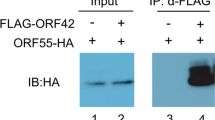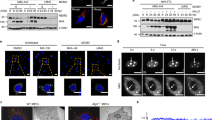Abstract
Varicella-zoster virus (VZV) is a neurotropic alphaherpesvirus that causes chickenpox and shingles. ORF7 is an important virulence determinant of VZV in both human skin and nerve tissues, however, its specific function and involved molecular mechanism in VZV pathogenesis remain largely elusive. Previous yeast two-hybrid studies on intraviral protein-protein interaction network in herpesviruses have revealed that VZV ORF7 may interact with ORF53, which is a virtually unstudied but essential viral protein. The aim of this study is to identify and characterize VZV ORF53, and to investigate its relationship with ORF7. For this purpose, we prepared monoclonal antibodies against ORF53 and, for the first time, characterized it as a ~40 kDa viral protein predominantly localizing to the trans-Golgi network of the infected host cell. Next, we further confirmed the interaction between ORF7 and ORF53 by co-immunoprecipitation and co-localization studies in both plasmid-transfected and VZV-infected cells. Moreover, interestingly, we found that ORF53 lost its trans-Golgi network localization and became dispersed in the cytoplasm of host cells infected with an ORF7-deleted recombinant VZV, and thus ORF7 seems to play a role in normal subcellular localization of ORF53. Collectively, these results suggested that ORF7 and ORF53 may function as a complex during infection, which may be implicated in VZV pathogenesis.

Article PDF
Similar content being viewed by others
Avoid common mistakes on your manuscript.
References
Albecka A, Owen DJ, Ivanova L, Brun J, Liman R, Davies L, Ahmed MF, Colaco S, Hollinshead M, Graham SC, Crump CM. 2017. Dual function of the pul7-pul51 tegument protein complex in herpes simplex virus 1 infection. J Virol, 91. pii: e02196–16.
Barr AR, Kilmartin JV, Gergely F. 2010. Cdk5rap2 functions in centrosome to spindle pole attachment and DNA damage response. J Cell Biol, 189: 23–39.
Charles AS, Chouljenko VN, Jambunathan N, Subramanian R, Mottram P, Kousoulas KG. 2014. Phenylalanine residues at the carboxyl terminus of the herpes simplex virus 1 ul20 membrane protein regulate cytoplasmic virion envelopment and infectious virus production. J Virol, 88: 7618–7627.
Cohen JI, Straus SE, Arvin AM. 2007. Fields virology, 5th edn. Philadelphia: Lippincott Williams & Wilkins, pp. 2773–2818.
Donsante A, Yi L, Zerfas PM, Brinster LR, Sullivan P, Goldstein DS, Prohaska J, Centeno JA, Rushing E, Kaler SG. 2011. Atp7a gene addition to the choroid plexus results in long-term rescue of the lethal copper transport defect in a menkes disease mouse model. Mol Ther, 19: 2114–2123.
Drolet M, Brisson M, Schmader KE, Levin MJ, Johnson R, Oxman MN, Patrick D, Blanchette C, Mansi JA. 2010. The impact of herpes zoster and postherpetic neuralgia on health-related quality of life: A prospective study. CMAJ, 182: 1731–1736.
Gilden DH, Kleinschmidt-DeMasters BK, LaGuardia JJ, Mahalingam R, Cohrs RJ. 2000. Neurologic complications of the reactivation of varicella-zoster virus. N Engl J Med, 342: 635–645.
Grigoryan S, Kinchington PR, Yang IH, Selariu A, Zhu H, Yee M, Goldstein RS. 2012. Retrograde axonal transport of vzv: Kinetic studies in hesc-derived neurons. J Neurovirol, 18: 462–470.
Jiang HF, Wang W, Jiang X, Zeng WB, Shen ZZ, Song YG, Yang H, Liu XJ, Dong X, Zhou J, Sun JY, Yu FL, Guo L, Cheng T, Rayner S, Zhao F, Zhu H, Luo MH. 2017. Orf7 of varicellazoster virus is required for viral cytoplasmic envelopment in differentiated neuronal cells. J Virol, 91: e00127–17.
Johnson RW, Bouhassira D, Kassianos G, Leplege A, Schmader KE, Weinke T. 2010. The impact of herpes zoster and post-herpetic neuralgia on quality-of-life. BMC Med, 8: 37.
Lukas K, Edte A, Bertrand I. 2012. The impact of herpes zoster and post-herpetic neuralgia on quality of life: Patient-reported outcomes in six european countries. Z Gesundh Wiss, 20: 441–451.
Luo WX, Zhang J, Yang HJ, Li SW, Xie XY, Pang SQ, Li SJ, Xia NS. 2000. Construction and application of an escherichia coli high effective expression vector with an enhancer. Sheng Wu Gong Cheng Xue Bao, 16: 578–581.
Nonnenmacher ME, Cintrat JC, Gillet D, Weber T. 2015. Syntaxin 5-dependent retrograde transport to the trans-golgi network is required for adeno-associated virus transduction. J Virol, 89: 1673–1687.
Pillay S, Meyer NL, Puschnik AS, Davulcu O, Diep J, Ishikawa Y, Jae LT, Wosen JE, Nagamine CM, Chapman MS, Carette JE. 2016. An essential receptor for adeno-associated virus infection. Nature, 530: 108–112.
Roller RJ, Fetters R. 2015. The herpes simplex virus 1 ul51 protein interacts with the ul7 protein and plays a role in its recruitment into the virion. J Virol, 89: 3112–3122.
Selariu A, Cheng T, Tang Q, Silver B, Yang L, Liu C, Ye X, Markus A, Goldstein RS, Cruz-Cosme RS, Lin Y, Wen L, Qian H, Han J, Dulal K, Huang Y, Li Y, Xia N, Zhu H. 2012. Orf7 of varicella-zoster virus is a neurotropic factor. J Virol, 86: 8614–8624.
Stellberger T, Hauser R, Baiker A, Pothineni VR, Haas J, Uetz P. 2010. Improving the yeast two-hybrid system with permutated fusions proteins: The varicella zoster virus interactome. Proteome Sci, 8: 8.
Uetz P, Dong YA, Zeretzke C, Atzler C, Baiker A, Berger B, Rajagopala SV, Roupelieva M, Rose D, Fossum E, Haas J. 2006. Herpesviral protein networks and their interaction with the human proteome. Science, 311: 239–242.
Wang W, Cheng T, Zhu H, Xia NS. 2015. Insights into the function of tegument proteins from the varicella zoster virus. Science China-Life Sciences, 58: 739–749.
Weinke T, Edte A, Schmitt S, Lukas K. 2010. Impact of herpes zoster and post-herpetic neuralgia on patients’ quality of life: A patient-reported outcomes survey. Z Gesundh Wiss, 18: 367–374.
Zerboni L, Sen N, Oliver SL, Arvin AM. 2014. Molecular mechanisms of varicella zoster virus pathogenesis. Nat Rev Microbiol, 12: 197–210.
Zhang Z, Rowe J, Wang W, Sommer M, Arvin A, Moffat J, Zhu H. 2007. Genetic analysis of varicella-zoster virus orf0 to orf4 by use of a novel luciferase bacterial artificial chromosome system. J Virol, 81: 9024–9033.
Zhang Z, Selariu A, Warden C, Huang G, Huang Y, Zaccheus O, Cheng T, Xia N, Zhu H. 2010. Genome-wide mutagenesis reveals that orf7 is a novel vzv skin-tropic factor. PLoS Pathog, 6: e1000971.
Zhao Y, Wang Y, Hu J, Zhang X, Zhang YW. 2012. Cuta divalent cation tolerance homolog (escherichia coli) (cuta) regulates beta-cleavage of beta-amyloid precursor protein (app) through interacting with beta-site app cleaving protein 1 (bace1). J Biol Chem, 287: 11141–11150.
Acknowledgments
This work was supported by the National Natural Science Foundation of China (No. 81601762), the National Science and Technology Major Project of Infectious Diseases (No. 2017ZX10304402), the National Science and Technology Major Projects for Major New Drugs Innovation and Development (No. 2017ZX09101005-005-003) and the Scientific Research Foundation of State Key Laboratory of Molecular Vaccinology and Molecular Diagnostics (No. 2016ZY005).
Author information
Authors and Affiliations
Corresponding authors
Rights and permissions
Open Access This article is distributed under the terms of the Creative Commons Attribution 4.0 International License (https://creativecommons.org/licenses/by/4.0/), which permits unrestricted use, distribution, and reproduction in any medium, provided you give appropriate credit to the original author(s) and the source, provide a link to the Creative Commons license, and indicate if changes were made.
About this article
Cite this article
Wang, W., Fu, W., Pan, D. et al. Varicella-zoster virus ORF7 interacts with ORF53 and plays a role in its trans-Golgi network localization. Virol. Sin. 32, 387–395 (2017). https://doi.org/10.1007/s12250-017-4048-x
Received:
Accepted:
Published:
Issue Date:
DOI: https://doi.org/10.1007/s12250-017-4048-x




